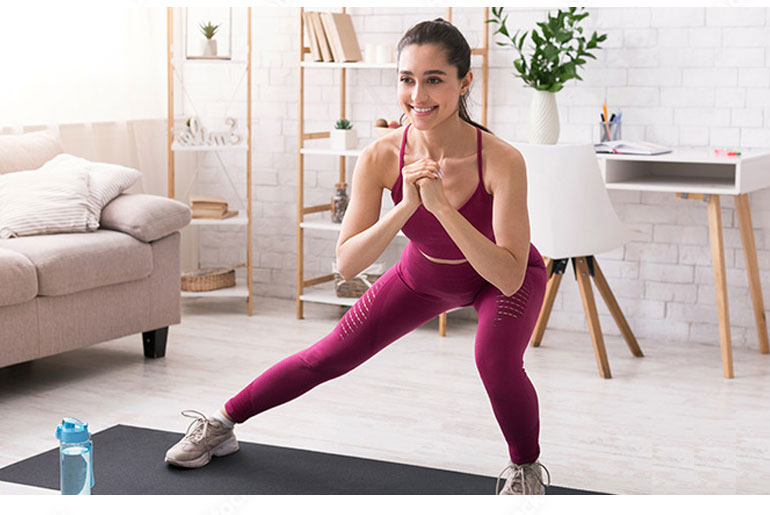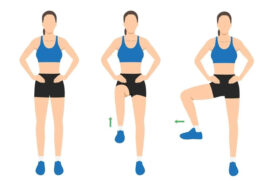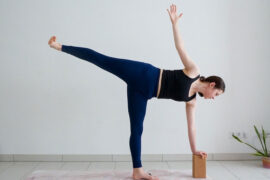Indoor exercises offer a convenient and effective way to stay fit and active, especially during unfavorable weather conditions like the summer heat or monsoon rains. These exercises can be done in the comfort of your home and require little to no equipment. Some popular indoor exercises include jumping jacks, high knees, burpees, bodyweight circuit training, yoga, dancing, and indoor cycling. They provide various benefits, such as improving cardiovascular fitness, strength, flexibility, balance, and mental well-being. With a diverse range of options available, you can create a well-rounded indoor workout routine that suits your fitness goals and preferences, ensuring you stay healthy and active all year round.
During the monsoon season, indoor exercises become a practical and effective way to stay fit and active while avoiding the challenges of outdoor workouts. Here are some of the best indoor exercises to keep you fit during the monsoon season:
-
Jump Rope:
Jump rope, also known as skipping rope, is a simple yet effective cardiovascular exercise that involves jumping over a rope while it passes under your feet and over your head. It’s a popular and fun way to get your heart rate up, burn calories, and improve coordination and agility.
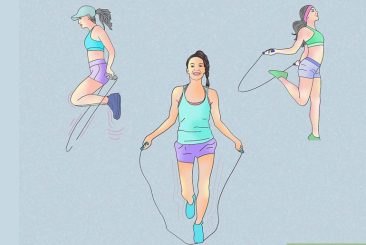
Here are some benefits and tips for jump rope exercise:
Benefits:
- Cardiovascular Fitness: Jumping rope is an excellent aerobic exercise that gets your heart pumping, improving cardiovascular health and stamina.
- Full-Body Workout: It engages multiple muscle groups, including your legs, core, arms, and shoulders, providing a full-body workout.
- Weight Loss: Jump rope can help with weight management and fat burning, making it an effective exercise for those aiming to lose weight.
- Improved Coordination and Agility: The constant timing and footwork required in jump rope exercises enhance coordination and agility.
- Portability: Jump ropes are portable and can be taken anywhere, making it a convenient workout option for home, travel, or gym.
Jump rope exercises can be adapted to suit various fitness levels, making it an excellent option for both beginners and experienced individuals. Always consult with a healthcare professional before starting any new exercise routine, especially if you have any health concerns or conditions. Enjoy the benefits of jump rope and have fun while staying fit!
-
Bodyweight Circuit Training:
Bodyweight circuit training is a highly effective and versatile Indoor Exercises that utilizes only your body weight as resistance. It involves performing a series of exercises one after the other, targeting different muscle groups, and often includes cardiovascular elements to elevate your heart rate. This type of training is great for building strength, endurance, and improving overall fitness without the need for any equipment.
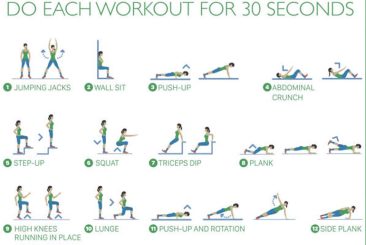
Here’s how you can set up a bodyweight circuit training routine:
- Choose Exercises: Select a variety of bodyweight exercises that target different muscle groups. Examples include push-ups, squats, lunges, planks, mountain climbers, burpees, jumping jacks, and sit-ups.
- Create a Circuit: Organize the exercises into a circuit. Aim for 5 to 10 different exercises, depending on your fitness level and time availability.
- Set Work and Rest Intervals: Decide on the duration for each exercise and rest period between exercises. For beginners, start with 30 seconds of exercise followed by 15 to 30 seconds of rest. As you progress, you can increase the exercise duration or decrease the rest time.
- Warm-Up: Before starting the circuit, perform a brief warm-up to get your muscles ready. You can do light cardio, such as jogging in place, jumping jacks, or arm circles.
- Perform the Circuit: Begin the circuit and perform each exercise for the specified time, moving from one exercise to the next without much rest in between. Complete the entire circuit.
- Rest and Repeat: After completing the circuit, take a longer rest period of around 1 to 2 minutes before starting the circuit again. Aim for 2 to 4 rounds of the circuit, depending on your fitness level and time available.
- Cool Down: After finishing all rounds, cool down with some static stretching to relax your muscles.
Benefits of Bodyweight Circuit Training:
- Full-Body Workout: The circuit targets multiple muscle groups, providing a complete full-body workout.
- Time-Efficient: Bodyweight circuit training can be done in a relatively short amount of time, making it suitable for busy schedules.
- No Equipment Needed: As it requires no equipment, you can perform bodyweight circuit training anywhere, whether at home, a park, or a hotel room.
- Scalable to All Fitness Levels: You can adjust the intensity of the exercises and rest periods to suit your fitness level.
- Improves Cardiovascular Fitness: The circuit format elevates your heart rate, improving cardiovascular endurance.
Remember to maintain proper form during each exercise to prevent injuries. If you’re new to circuit training, start with a shorter and less intense circuit, gradually increasing the duration and intensity as you become more comfortable and conditioned. As with any new exercise program, consult with a healthcare professional if you have any medical concerns or conditions. Enjoy the benefits of bodyweight circuit training and stay fit!
-
Jumping Jacks:
Jumping jacks are a classic and effective Indoor Exercises that involves jumping while simultaneously spreading your legs and raising your arms above your head. It’s a great full-body workout that offers numerous benefits and can be easily performed in a small indoor space.
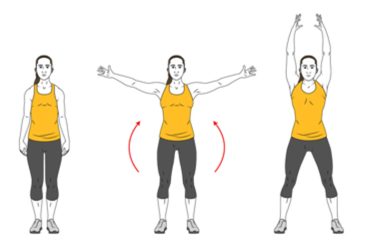
Here’s how to do jumping jacks:
- Stand with your feet together and your arms at your sides, maintaining proper posture with your shoulders relaxed and back straight.
- In one fluid motion, jump and spread your legs out to the sides while raising your arms above your head. Your legs should be wider than shoulder-width apart, and your arms should touch or come close to touching above your head.
- As you land softly, bring your legs back together and lower your arms to the starting position at your sides.
- Repeat the motion for the desired number of repetitions or within a set duration.
Benefits of Jumping Jacks:
- Cardiovascular Fitness: Jumping jacks are an excellent aerobic exercise that increases your heart rate and improves cardiovascular endurance.
- Full-Body Workout: This exercise engages multiple muscle groups, including your legs, core, arms, and shoulders, providing a comprehensive full-body workout.
- Calorie Burning: Jumping jacks are an effective calorie-burning exercise, making them beneficial for weight loss and weight management.
- Bone Health: The impact of landing during jumping jacks can help improve bone density and strength.
- Coordination and Agility: The rhythmic and coordinated movement of jumping jacks can enhance your coordination and agility.
- No Equipment Needed: Jumping jacks require no special equipment, making them a convenient and accessible exercise.
Jumping jacks are a versatile exercise that can be integrated into various fitness routines. As with any exercise, listen to your body and consult with a healthcare professional if you have any medical concerns or conditions. Incorporate jumping jacks into your indoor workout routine to enjoy their many fitness benefits.
-
Yoga:
Yoga is a holistic mind-body practice that originated in ancient India and has been practiced for thousands of years. It combines physical postures (asanas), breathing techniques (pranayama), meditation, and relaxation to promote overall well-being and harmony.
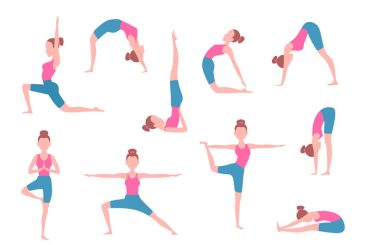
Here are some key aspects and benefits of practicing yoga:
- Physical Benefits: Yoga helps improve flexibility, strength, and balance. Regular practice can lead to increased muscle tone, improved posture, and better joint health.
- Mental Benefits: Yoga incorporates mindfulness and meditation, which can reduce stress, anxiety, and depression. It promotes mental clarity, focus, and a sense of inner peace.
- Breathing Techniques: Pranayama, or breath control, is an essential part of yoga. Various breathing exercises can calm the mind, regulate the nervous system, and enhance lung capacity.
- Stress Reduction: Yoga’s emphasis on relaxation and mindfulness helps reduce the effects of stress on the body and mind. It encourages a state of tranquility and relaxation.
- Increased Body Awareness: Yoga encourages a deeper connection with your body, allowing you to listen to its signals and needs more effectively.
- Better Sleep: Regular yoga practice has been shown to improve sleep quality and promote better sleep patterns.
- Mind-Body Connection: Yoga fosters a strong connection between the body and mind, promoting a sense of self-awareness and self-acceptance.
- Adaptability: Yoga can be adapted to suit people of all ages, fitness levels, and physical abilities. There are various styles and levels of yoga classes available, making it accessible to everyone.
- Injury Prevention: Yoga’s emphasis on proper alignment and controlled movements can help prevent injuries and improve overall body awareness.
- Enhanced Flexibility and Range of Motion: Through the practice of yoga poses, you can gradually increase your flexibility and range of motion, reducing muscle stiffness and tension.
Yoga can be practiced in a class setting, where an instructor guides the participants through various poses and sequences. Alternatively, it can be practiced at home using online resources or yoga apps. There are many different styles of yoga, such as Hatha, Vinyasa, Ashtanga, Bikram, and more, each offering unique benefits and focusing on different aspects of the practice.
-
Dancing:
Dancing is not only a form of artistic expression but also a fantastic way to stay fit and active. Whether you take formal dance classes or simply dance for fun, it offers numerous physical and mental health benefits. Here’s why dancing is an excellent Indoor Exercises:
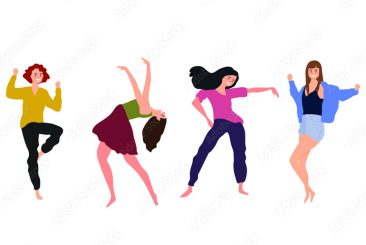
- Cardiovascular Fitness: Dancing is a great cardiovascular workout that gets your heart rate up, improving your cardiovascular endurance and overall cardiovascular health.
- Full-Body Workout: Different dance styles engage various muscle groups, providing a full-body workout. It can tone and strengthen muscles in your legs, core, arms, and back.
- Balance and Coordination: Dancing requires balance and coordination, which can help improve your body awareness and agility.
- Flexibility: Many dance movements involve stretching and reaching, promoting flexibility and increased range of motion.
- Weight Management: Dancing can burn a significant number of calories, making it beneficial for weight management and fat loss.
- Mood Booster: Dancing releases endorphins, the “feel-good” hormones, which can elevate your mood and reduce stress and anxiety.
- Social Interaction: Taking dance classes or participating in group dance activities provides social interaction and a sense of community, contributing to overall well-being.
- Cognitive Benefits: Learning dance routines and choreography can challenge your brain and improve memory and cognitive function.
- Bone Health: Dancing is weight-bearing exercise, which can help improve bone density and reduce the risk of osteoporosis.
- Self-Expression and Confidence: Dancing allows you to express yourself creatively and build self-confidence as you improve your dance skills.
Dancing can be tailored to suit people of all ages, fitness levels, and abilities. You can choose from various dance styles, such as hip-hop, salsa, ballet, contemporary, ballroom, and many more. Additionally, dancing can be done in the comfort of your own home, at dance studios, or even at dance parties.
Remember to warm up before starting your indoor workout and cool down afterward. Stay hydrated and listen to your body during exercises to avoid overexertion. You can mix and match these indoor exercises to create a varied and enjoyable fitness routine during the monsoon season.
Disclaimer:
The information contained in this article is for educational and informational purposes only and is not intended as a health advice. We would ask you to consult a qualified professional or medical expert to gain additional knowledge before you choose to consume any product or perform any exercise.

